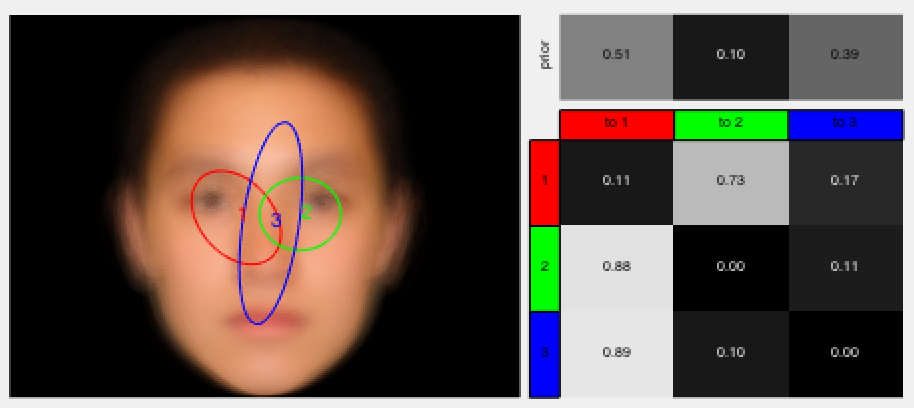
Recent research has reported substantial individual differences in eye movement patterns in cognitive tasks. Thus, it is important to take these individual differences into account in eye movement data analysis. In this project we use hidden Markov models (HMM) to analyze eye movement data. In our approach, each individual’s eye movements are modeled with an HMM, including both person-specific regions of interests (ROIs) and transitions among the ROIs. Individual HMMs are then clustered to discover common patterns among individuals. The similarities between an individual’s eye movement patterns and the group behavior can be quantitatively assessed (using likelihood), and correlated with other behavioral data (e.g., recognition accuracy).
Through clustering individuals’s HMMs, our approach finds two common patterns in face recognition: holistic (looking mostly at the face center) and analytic (looking mostly at the two eyes in addition to the mouth).
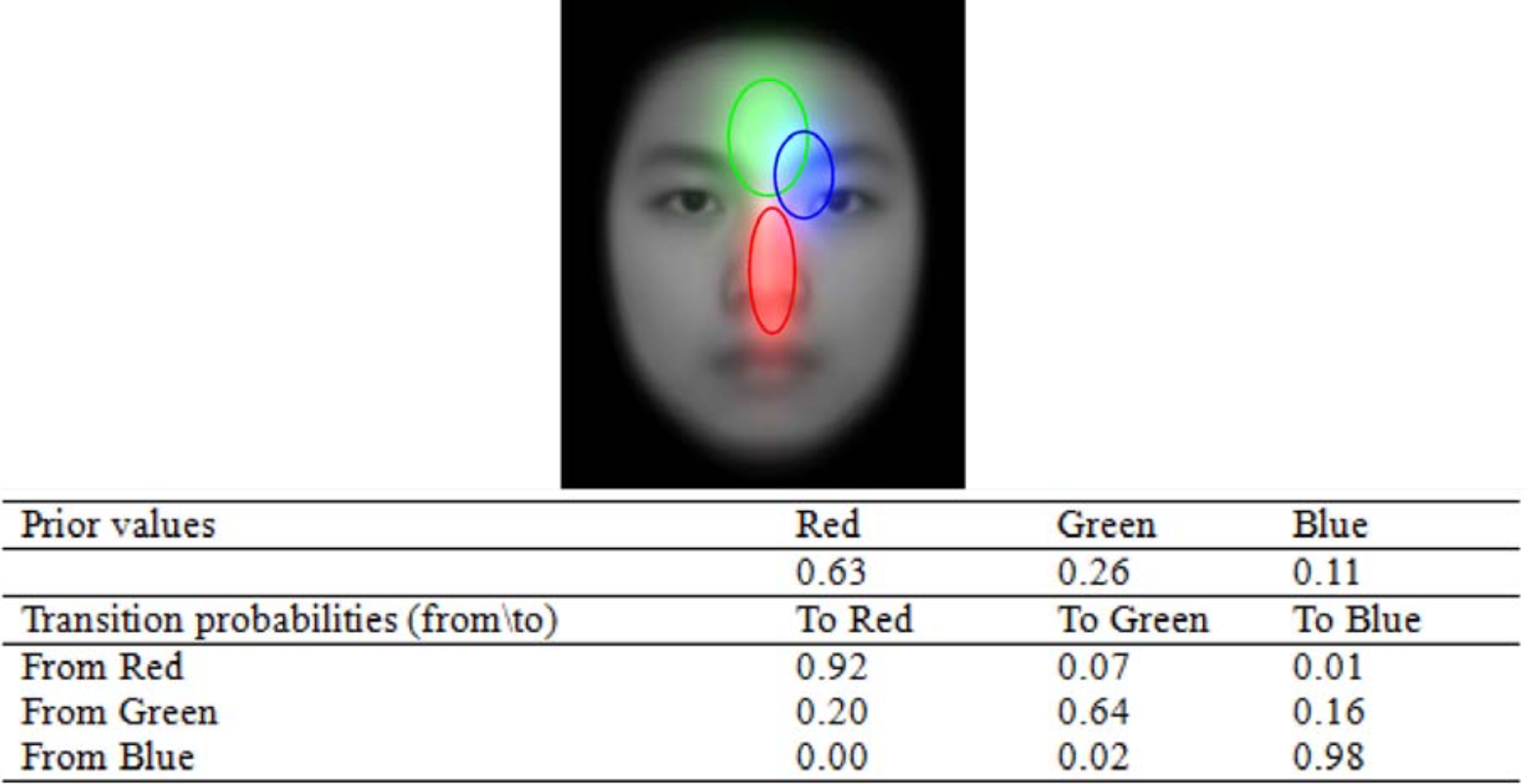
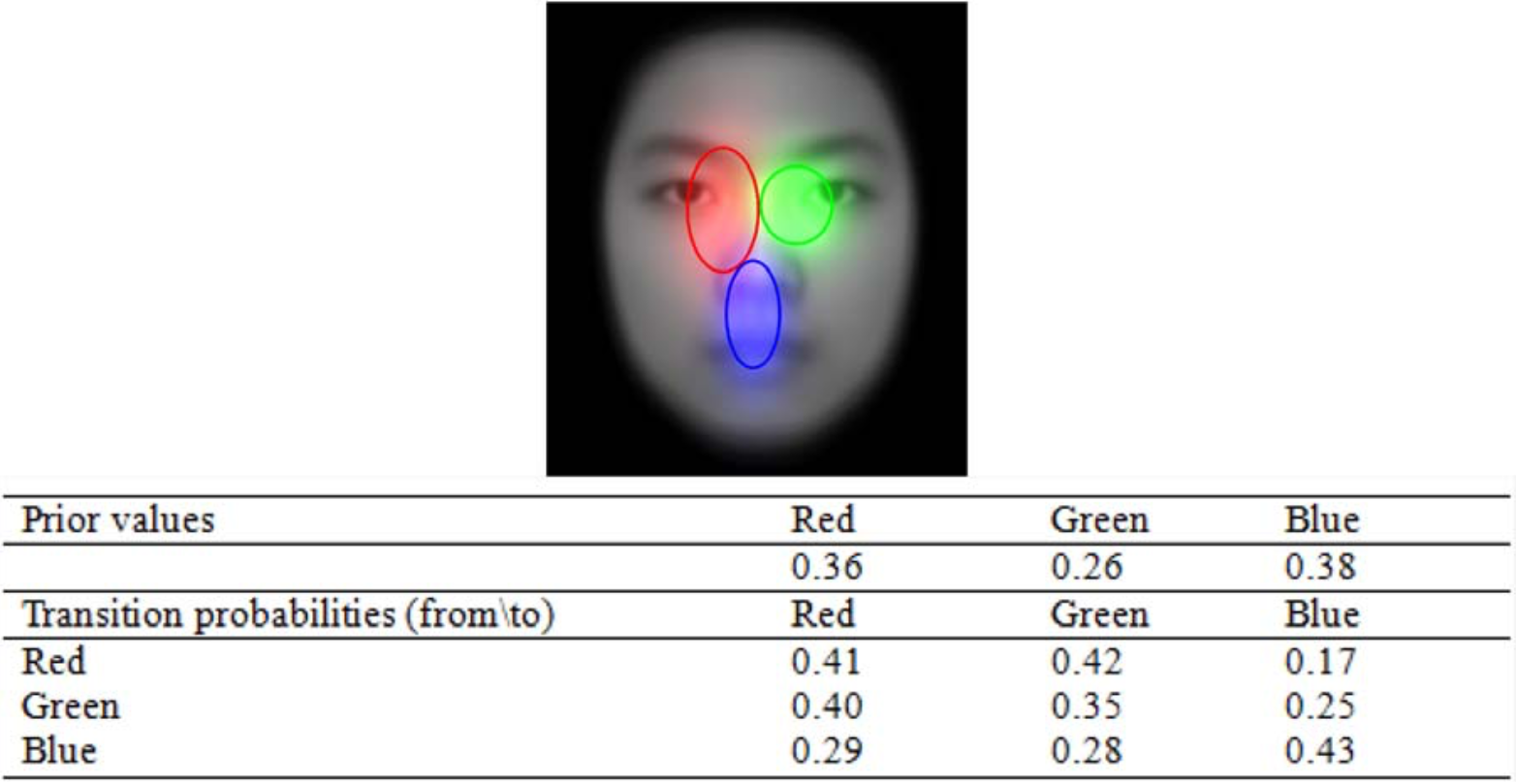
The frequency of participants adopting the two patterns did not differ significantly between Asians and Caucasians. Significantly more participants showed similar eye movement patterns when viewing own- and other-race faces than different patterns, suggesting little modulation from culture. In contrast to the scan path theory, which posits that eye movements during learning have to be recapitulated during recognition for the recognition to be successful, participants who used the same or different patterns during learning and recognition did not differ in recognition performance. Interestingly, analytic patterns were associated with better face recognition performance and higher activation in brain regions important for top-down control of visual attention, whereas holistic patterns were associated with aging and lower cognitive status in older adults.
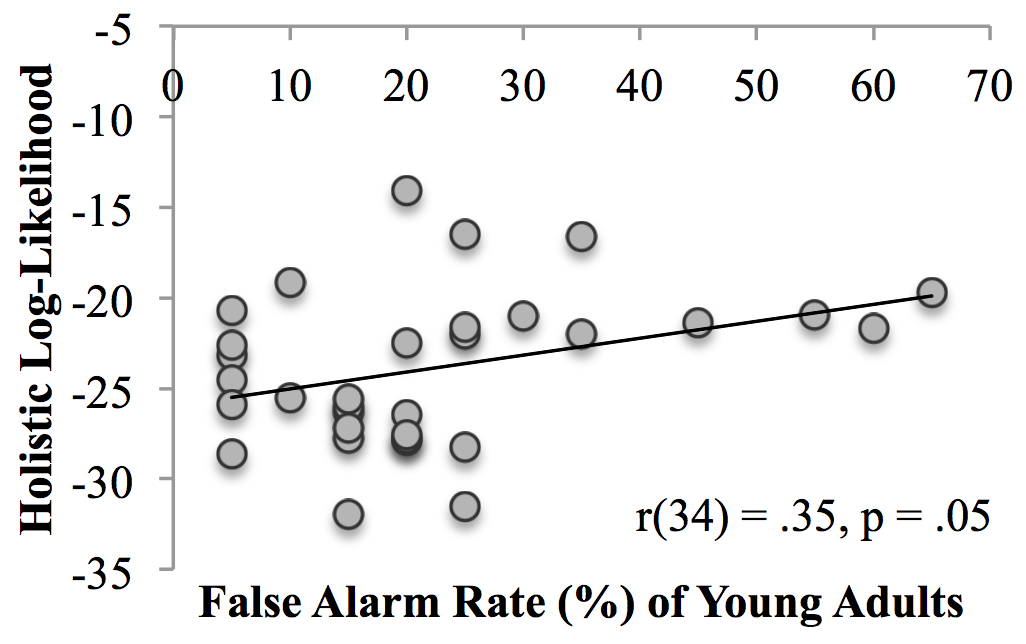
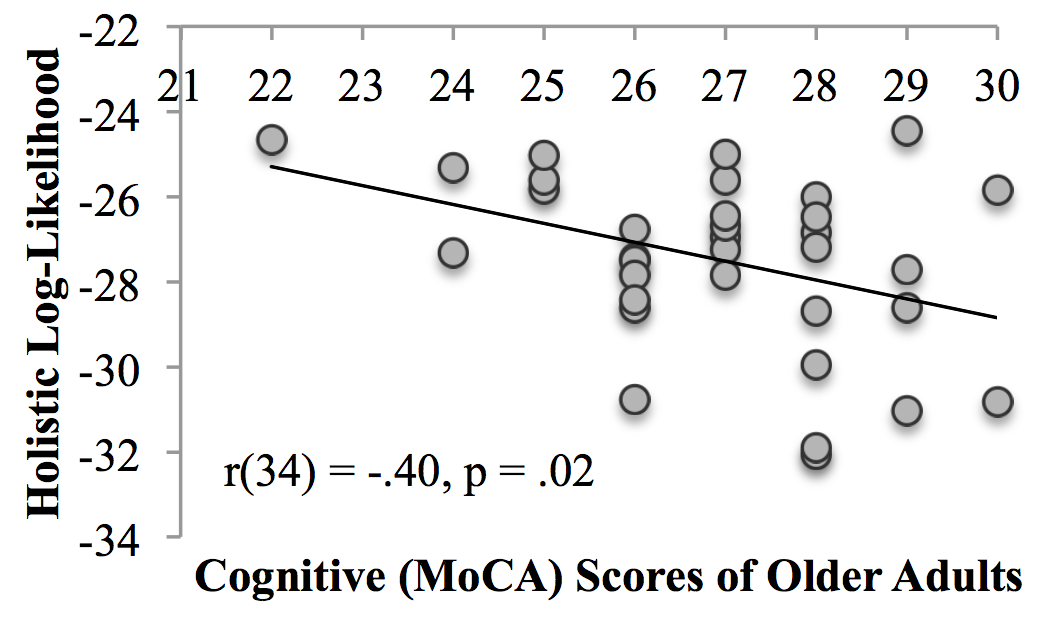
We have also applied similar models to analyze eye movements on webpages in order to discover differences in information system usage among experienced/inexperienced and pressure/non-pressured users.
EMHMM with Co-clustering
The above approach assumes that the feature layouts of the stimuli are similar to each other (e.g., the faces are aligned), so that aggregating fixations across the images makes sense. In some experiment designs, this is not possible, e.g., in scene viewing experiments where each image has a different layout. To handle images with different layouts, we apply co-clustering to group individuals that share similar eye gaze patterns among all images. With co-clustering, representative HMMs are estimated for each image separately, and individuals are grouped together if they have similar eye gaze (on each image) to other group members. Here is an illustration:

Each subject Si has an HMM to summarize their eye movements on each stimuli Ij. Here the ellipses represent the ROIs. Co-clustering will group subjects whose eye movement patterns are similar to one another when viewing each stimuli. In this toy example, S1 and S2 are grouped together because they have similar eye movements when looking at I1, I2, and I3. Similarly, S3 and S4 are grouped together.
We applied the co-clustering algorithm to a scene-viewing experiment, and discover two strategies, Explorative and Focused. Here are examples of the two groups for two different stimuli.
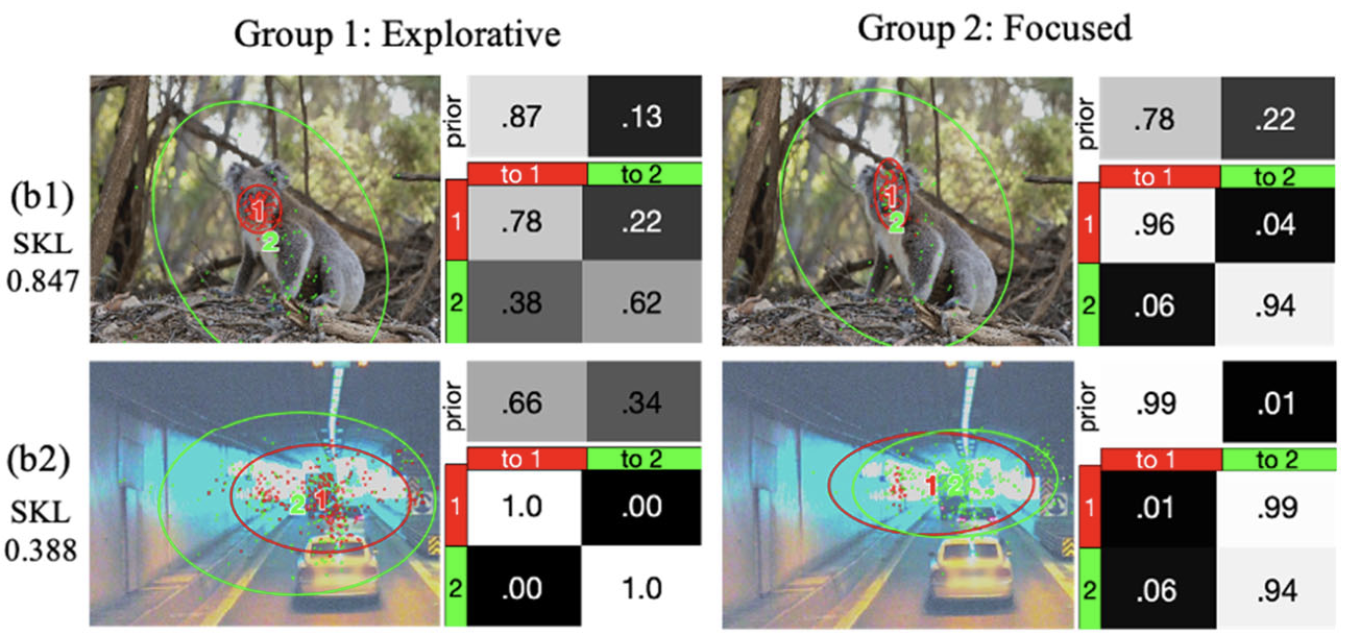
The explorative group tends to look at the center of the Koala’s face, while the focused group looks more at the eye region. Once we have the group HMMs, the similarity of each subject’s eye movements to the two groups can be quantified and used for further analysis.
Downloads
This is the MATLAB toolbox for analyzing eye movement data using hidden Markov models. It includes code for learning HMMs for individuals, clustering individuals’ HMMs into groups, and co-clustering of HMMs into groups. There are also functions for performing statistical tests and analyzing the HMMs.
- Files: emhmm-toolbox v0.80
- Version History: Change Log
- Slides: Intro Slides (10MB); Matlab Tutorial Slides (20MB)
- If you use this toolbox please cite (as appropriate):
Understanding eye movements in face recognition using hidden Markov models.
,
Journal of Vision, 14(11):8, Sep 2014.Clustering hidden Markov models with variational HEM.
,
Journal of Machine Learning Research (JMLR), 15(2):697-747, Feb 2014. [code]Eye Movement analysis with Hidden Markov Models (EMHMM) with co-clustering.
,
Behavior Research Methods, 53:2473-2486, April 2021.Clustering Hidden Markov Models With Variational Bayesian Hierarchical EM.
,
IEEE Trans. on Neural Networks and Learning Systems (TNNLS), 34(3):1537-1551, March 2023 (online 2021).
Research Labs
- Attention Brain & Cognition Lab (PI: Janet Hsiao), Hong Kong University of Science & Technology.
- Video, Image, and Sound Analysis Lab (PI: Antoni Chan), City University of Hong Kong.
Publications
Journals
- Collaborative contrastive learning for cross-domain gaze estimation.
,
Pattern Recognition, 161:111244, May 2025. - Visual attention to own- vs. other-race faces: Perspectives from learning mechanisms and task demands.
,
British Journal of Psychology, 114(S1):17-20, May 2023. - On Becoming Socially Anxious: Toddlers’ Attention Bias to Fearful Faces.
,
Developmental Psychology, 59(2):353-363, Feb 2023. - Understanding the role of eye movement consistency in face recognition and autism through integrating deep neural networks and hidden Markov models.
,
npj Science of Learning, 7:28, Oct 2022. - Understanding children's attention to traumatic dental injuries using eye-tracking.
,
Dental Traumatology, 38(5):410-416, Oct 2022. - Understanding children’s attention to dental caries through eye-tracking.
,
Caries Research, 56(2):129-137, June 2022. - Eye movement analysis of children's attention for midline diastema.
,
Scientific Reports, 12:7462, May 2022. - The effects of attentional and interpretation biases on later pain outcomes among younger and older adults: A prospective study.
,
European Journal of Pain, 26(1):181-196, Jan 2022. - Understanding the collinear masking effect in visual search through eye tracking.
,
Psychonomic Bulliten & Review, 28(6):1933-1943, Dec 2021. - Do portrait artists have enhanced face processing abilities? Evidence from hidden Markov modeling of eye movements.
,
Cognition, 211(104616), June 2021. - Eye Movement analysis with Hidden Markov Models (EMHMM) with co-clustering.
,
Behavior Research Methods, 53:2473-2486, April 2021. - Understanding visual attention to face emotions in social anxiety using hidden Markov models.
,
Cognition and Emotion, 34(8):1704-1710, Dec 2020. - The interrelation between interpretation biases, threat expectancies and pain-related attentional processing.
,
European Journal of Pain, 24(10):1956-1967, Nov 2020. - Interpretation biases and visual attention in the processing of ambiguous information in chronic pain.
,
European Journal of Pain, 24(7):1242-1256, Aug 2020. - Eye movement analysis with switching hidden Markov models.
,
Behavior Research Methods, 52:1026-1043, June 2020. [appendix] - Individuals with Insomnia Misrecognize Angry Faces as Fearful Faces While Missing the Eyes: An Eye-Tracking Study.
,
SLEEP, 42(2), zsy220, Feb 2019. - Eye Movement Patterns in Face Recognition are Associated with Cognitive Decline in Older Adults.
,
Psychonomic Bulletin & Review, 25(6):2200-2207, Dec 2018. - Scanpath modeling and classification with Hidden Markov Models.
,
Behavior Research Methods, 50:362-379, Feb 2018. - Is having similar eye movement patterns during face learning and recognition beneficial for recognition performance? Evidence from hidden Markov modeling.
,
Vision Research, 141:204-216, Dec 2017. - Hidden Markov model analysis reveals the advantage of analytic eye movement patterns in face recognition across cultures.
,
Cognition, 169:102-117, Dec 2017. - Understanding eye movements in face recognition using hidden Markov models.
,
Journal of Vision, 14(11):8, Sep 2014.
-
Modulation of mood on eye movement pattern and performance in face recognition.
Emotion, (in press).
Peer-Reviewed Conference Proceedings / Poster Sessions
- Eye movement behavior during mind wandering in older adults.
,
In: Annual Conference of the Cognitive Science Society (CogSci), San Francisco, to appear Jul 2025. - Is Holistic Processing Associated with Face Scanning Pattern and Performance in Face Recognition? Evidence from Deep Neural Network with Hidden Markov Modeling.
,
In: Annual Conference of the Cognitive Science Society (CogSci), Rotterdam, Jul 2024. - Eye Movement Behavior during Mind Wandering across Different Tasks in Interactive Online Learning.
,
In: Annual Conference of the Cognitive Science Society (CogSci), Rotterdam, Jul 2024. - Use of online therapy session data to develop behavioural markers for cognitive outcomes in non-pharmacological intervention.
,
In: Alzheimer's Association International Conference (AAIC), Amsterdam, July 2023. - The role of eye movement consistency in learning to recognise faces: Computational and experimental examinations.
,
In: 42nd Annual Conference of the Cognitive Science Society (CogSci), Jul 2020. - Understanding Individual Differences in Eye Movement Pattern During Scene Perception through Co-Clustering of Hidden Markov Models.
,
In: The Annual Meeting of the Cognitive Science Society (CogSci), Montreal, Jul 2019. - Hidden Markov modelling of eye movements in social anxiety: a data-driven machine-learning approach to eye-tracking research in psychopathology.
,
In: 2019 Anxiety & Depression Conference, Chicago, March 2019. - Music Reading Expertise Facilitates English but not Chinese sentence reading: Evidence from Eye Movement Behavior.
,
In: 15th International Conference on Music Perception and Cognition (ICMPC15), Sydney, July 2018. - Insomniacs Misidentify Angry Faces as Fearful Faces Because of Missing the Eyes: an Eye-Tracking Study.
,
In: The Annual Meeting of the Cognitive Science Society (CogSci), London, July 2017. - Mind reading: Discovering individual preferences from eye movements using switching hidden Markov models.
,
In: The Annual Meeting of the Cognitive Science Society (CogSci), Philadelphia, Aug 2016. - Analytic Eye Movement Patterns in Face Recognition are Associated with Better Performance and more Top-down Control of Visual Attention: an fMRI Study.
,
In: The Annual Meeting of the Cognitive Science Society (CogSci), Philadelphia, Aug 2016. - Hidden Markov Modeling of eye movements with image information lead to better discovery of regions of interest.
,
In: The Annual Meeting of the Cognitive Science Society (CogSci), Philadelphia, Aug 2016. - Hidden Markov model analysis reveals better eye movement strategies in face recognition.
,
In: The Annual Meeting of the Cognitive Science Society (CogSci):393-398, Pasadena, Jul 2015. - Eye Movement Pattern in Face Recognition is Associated with Cognitive Decline in the Elderly.
,
In: The Annual Meeting of the Cognitive Science Society (CogSci):321-326, Pasadena, Jul 2015. - Global and Local Priming Evoke Different Face Processing Strategies: Evidence From An Eye Movement Study.
,
In: Annual meeting of the Vision Sciences Society (VSS), St. Pete Beach, Florida, May 2015. - Caucasian and Asian eye movement patterns in face recognition: A computational exploration using hidden Markov models.
,
In: Annual meeting of the Vision Sciences Society (VSS), May 2014. - Understanding eye movements in face recognition with hidden Markov model.
,
In: 6th Chinese International Conference on Eye Movements (CICEM), Beijing, May 2014 (oral). - Objective Measures of IS Usage Behavior Under Conditions of Experience and Pressure Using Eye Fixation Data.
,
In: International Conference on Information Systems (ICIS), Milan, Dec 2013. - Understanding eye movements in face recognition with hidden Markov model.
,
In: The Annual Meeting of the Cognitive Science Society (CogSci), Berlin, Aug 2013 (oral, Student travel award winner).
Invited Talks/Conference Oral Presentations
-
Deep Neural Net + Hidden Markov Model (DNN + HMM): A Novel Framework for understanding human learning.
CogSci 2022 Hong Kong Meetup & Symposium, July 2022. -
Eye Movement analysis with Hidden Markov Models (EMHMM) and Its Applications in Cognitive Research.
CogSci 2021 Hong Kong Meetup & Symposium, July 2021. -
Mini-Course in Eye Movement Analysis With Hidden Markov Models.
,
National Taiwan University, Aug 12-16, 2019. -
EMHMM: Eye Movement Analysis with Hidden Markov Models and Its Applications in Cognitive Research.
,
Tutorial in The Annual Meeting of the Cognitive Science Society (CogSci), July 2019. -
Understanding Eye Movement Patterns in Face Recognition Using Hidden Markov Models.
,
Symposium on Understanding Individual Differences in Eye Movement Patterns, Asia Pacific Conference on Vision, July 2017. -
Classifying eye gaze patterns and inferring individual preferences using hidden Markov models.
,
Symposium on Understanding Individual Differences in Eye Movement Patterns, Asia Pacific Conference on Vision, July 2017. -
Understanding eye movement patterns in face recognition using hidden Markov models.
,
Invited Department Seminar at the Department of Psychology, National Taiwan University, 2017. -
On Associations Between Eye Movement Patterns and Face Recognition Performance: The Effects of Culture and Age.
,
Invited talk at the German Graduate School of Management and Law (GGS), 2016. -
Eye Movement Pattern in Face Recognition is Associated with Cognitive Decline in the Elderly.
,
Invited talk at the HKU International Alzheimer’s Disease Conference, 2015. -
Eye Movement Pattern in Face Recognition is Associated with Cognitive Decline in the Elderly.
,
Invited talk at the Department of Information Systems and Information Economics, Goethe University Frankfurt, 2015. -
Understanding eye movements in face recognition with hidden Markov model.
,
Invited talk at the 6th Chinese International Conference on Eye Movements (CICEM), Beijing, China, 2014.
- Objective Measures of IS Usage Behavior Under Conditions of Experience and Pressure Using Eye Fixation Data.
,
In: International Conference on Information Systems (ICIS), Milan, Dec 2013. - Understanding eye movements in face recognition with hidden Markov model.
,
In: The Annual Meeting of the Cognitive Science Society (CogSci), Berlin, Aug 2013 (oral, Student travel award winner).
Acknowledgements
We are grateful for support from the Research Grant Council of Hong Kong SAR: #17609117, #17402814 and HKU 745210H for J.H. Hsiao; CityU 110513 and G-CityU109/14 for A.B. Chan. We also thank the HKU Seed Funding Programme for Basic Research (Project numbers 201311159131 and 201811159165) to J.H. Hsiao. We also thank the Strategic Research Grant from City University of Hong Kong (Project No. 7005218) to A.B. Chan.
